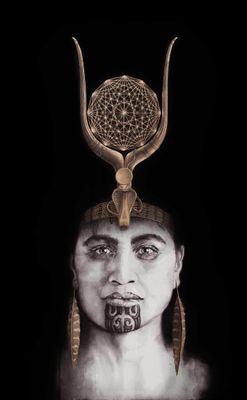

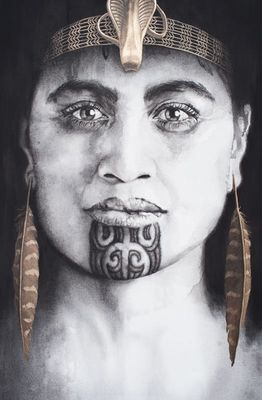
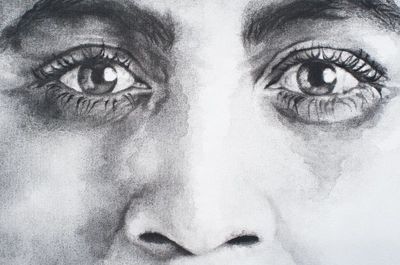
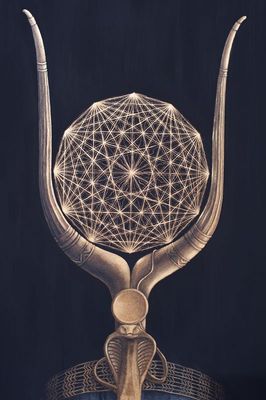
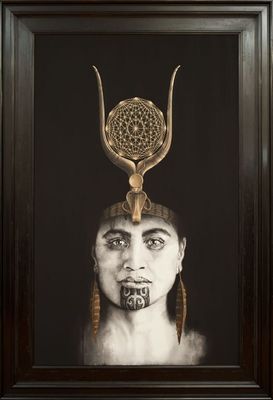
Queen of Raa
This product option is unavailable. View other options.
Explore the story of the artwork >>
Print sizes and editions
- Regular museum archival paper print - 805 x 500mm
(limited to 275) - Large museum archival paper print - 1150 x 714mm
(limited to 195) - Extra Large museum canvas print - 1361 x 840mm
(limited to 175)
Your unique limited edition fine art print
- Sofia creates your signed, museum archival print
- We ship for $25 in NZ and from $50 internationally
- Your artwork arrives rolled, ready to be framed - do you need help? Request framing guidance
Original painting SOLD, flashe (vinyl paint) on canvas,1975 x 1350mm (including antique black frame), 2017
The story of Queen of Raa
Queen of Raa is a celebration of Mana Wāhine or The Divine Feminine. She brings together ancient Māori and Egyptian cosmology.
In my conception of her, she is a goddess and consort of the Sun, who is called Raa in both Māori and Egyptian mythology.
The sun and the moon
The sun is traditionally a masculine element. It is the fiery source, represented here in metallic, reflective gold. The female element is the moon; it is creation and birth. Her face is painted here using a black and white palette of moonlight.
Mana, whakapapa and unconditional love
The form of the goddess' face was inspired by all of my years of looking at classical 19th and 20th century photographs of Māori. She has the indelible mark of moko kauae - chin tattoo - which signifies her mana and whakapapa (lineage).
She embodies the unconditional love of the Māori goddess Hine-nui-te-pō - the Great Woman of the Long Night. Hine-nui-te-pō welcomes her children as they pass through the veil of life into death.
Ancient Egyptian influence
As she was taking shape on the canvas, I knew she would also have Egyptian goddess symbology. While I was researching her crown, I was drawn to the ancient Egyptian goddesses Isis and Hathor, who are often merged together in myth.
Isis was worshipped as the ideal mother and wife as well as the patroness of nature and magic. Isis is also known as protector of the dead and goddess of children. The name Isis means "Throne". Her headdress is often a throne, although not in this depiction. As the personification of the throne, she was an important representation of the pharaoh's true spiritual power. The pharaoh was depicted as her child, who sat on the throne she provided.
The divine fire of spiritual energy
The crown she is wearing has a uraeus, which is Greek for a rearing cobra on its tail. The uraeus serpent represents the divine fire of spiritual energy in the human body "rearing up" the spinal cord.
It ascends the chakra system, activating the pituitary and pineal glands, or third eye. This is located above the brow between the eyes. The snake in the human body is the spine. The spine is an important nervous centre and carrier of spiritual energy, known as Kundalini. The third eye is a direct doorway to the subconscious mind.
Awakening and ascension
Two feathers of a kārearea, a native New Zealand hawk, dangle from her ears. Usually Isis is depicted with the full outstretched wings of a kite hawk. Together with the rearing cobra, the kārearea feathers make for a powerful symbol of the winged serpent. It indicates the awakening and ascension of consciousness.
Nourishment and unification
Rising above her head are cow horns. These symbolise ultimate nourishment like the beloved cow's milk has been for human beings for centuries. This is the female element, curved in form, supporting and sustaining life.
And between the horns at the crown chakra above her head is a sacred geometric sun disk representing Raa. It is the source, firing with light. This energy centre is unification with The All.
Sofia Minson Paintings | New Zealand Artwork

